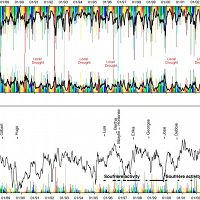Numerical Models
Numerical Models for LCZO
Hydrologic models that have been used in the Luquillo Mountains in the recent past have included the spatially explicit TOPOG (Schellekens et al 2004), statistically based-GIS models (Garcia et al 1996, Pike et al 2010) and most recently the tRIBS-VEGGIE distributed ecohydrologic model (Lepore et al 2011). These models have been used in a variety of ways including landscape characterization, predicting flood levels, and slope failures. Current efforts are focused on improving the soil moisture dynamics and vegetation representation in the tRIBS-VEGGIE model to be able to better predict landsliding and geologic hot-spots.
CENTURY
CENTURY Soil Carbon model
CENTURY Soil Carbon model has been used by the LCZO to understand the distribution of soil carbon across Luquillo watersheds.
GASH
ET and Throughfall
The LCZO builds upon a long history of research on ET and throughfall.
PHREEQC
PHREEQC
PHREEQC, stands for a “ph-redox-equilibrium-equation” model.
tRIBS
Real-time Integrated Basin Simulator -tRIBS
Real-time Integrated Basin Simulator -tRIBS
Physically distributed Hydrology Model: tRIBS-VEGGIE
The tRIBS-VEGGIE model is an eco-hydrological model that consists of a spatially distributed physically based hydrological model coupled to a model of plant physiology and spatial dynamics (Ivanov et al., 2008a; 2008b). The tRIBS model has the capability to explicitly consider the spatial variability in precipitation fields, land-surface descriptors and the corresponding moisture dynamics, stressing the role of topography in lateral soil moisture redistribution and accounting for the effects of heterogeneous and anisotropic soil. Basin hydrological response can be simulated at very fine temporal (sub-hourly) and on an irregular spatial mesh (10-lOOOm). The irregular mesh allows for the use of smaller computational elements to represent regions within the basin of interest while using larger elements for less critical regions..
The dynamics of each computational element in tRIBS-VEGGIE model are simulated separately but spatial dependencies are introduced by considering the surface and subsurface moisture transfers among the elements, which affect local dynamics via the coupled energy-water interactions. Consequently, when applied to a catchment, the model offers a quasi-three-dimensional framework by which lateral moisture transfers and difference in topographic characteristics may lead to the spatial-temporal variability of states (Ivanov et al., 2008b).
VEGGIE models the spatial distribution of vegetation types (e.g., trees vs. grasses), and pertinent properties of the vegetation state (e.g., vegetation fraction, leaf area index, biomass etc) (Ivanov et al., 2008a; 2008b) and enriches the hydrology model by accounting for vegetation characteristics that affect both water and energy balance dynamics. Aboveground, the canopy has the ability to intercept and retain precipitation that affects the soil infiltration process, and the energy budget. Below ground, vegetation influences the vertical distribution of soil moisture via plant water uptake, and to the cohesion of the soil-bedrock-root matrix, depending on the distribution of roots. VEGGIE utilizes the Plant Functional Type (PFT) vegetation classification scheme (Smith et al., 1997), and allows for a single computational element to simulate multiple PFTs that may differ in life form (e.g., tree, shrub, grass), vegetation physiology (e.g., leaf optical and photosynthetic properties), and structural attributes (e.g., height, leaf dimension, or root), each interplaying differently with the hydrological response of the basin.
The slope stability module involves the assessment of the Factor of Safety, FS, by applying limit equilibrium analysis. The Infinite Slope model is commonly used in literature and it provides a well determined static equation for the calculation of the FS (Taylor, 1948), as described in detailed in Arnone et al. (2011b). The approach used in Arnone et al. (2011b) for the landslide module accounts for the soil moisture in the unsaturated zone and water table dynamics, but it neglects the effect of matric suction when computing the FS and the corresponding shear strengths in unsaturated soils. The new factor of safety to be used in this effort now includes the matric suction effect and the role of vegetation in providing cohesion and resistance to landsliding as well as adding weight that promotes sliding.
Bonnin, G., D. Martin, B. Lin, T. Parzybok, M. Yekta, and D. Riley (2006). “Precipitation-Frequency Atlas of the United States” NOAA Atlas 14, Volume 3, Version 2.0. NOAA, National Weather Service, Silver Spring, MD http://hdsc.nws.noaa.gov/hdsc/pfds.
García-Martino A.R., Warner G.S., Scatena F.N., Civco D.L., 1996. GIS prediction of rainfall and runoff volumes in eastern Puerto Rico. Pages 417-426 in Hallam C.A., J.M. Salisbury, Lanfear K.J., Battaglin W.A., editors. American Water Resources Association, Herndon, VA TPS-96-3
Lepore, C. Kamal, S. A., Shanahan, P. Bras, R. L., 2011 Rainfall-induced landslide susceptibility zonation of Puerto Rico. Environmental Earth Science, 2011. DOI 10.1007/s12665-011-0976-
Pike A.S., F.N. Scatena, 2010. Riparian indicators of flow frequency in a tropical montane stream network. Journal of Hydrology 382:72-87
Schellekens J., Scatena F.N., Bruijnzeel L.A., van Dijk A.I. J.M., Groen M.M.A., van Hoogezand R.J.P., 2004. Stormflow generation in a small rain-forest catchment in the Luquillo Experimental Forest, Puerto Rico. Hydrological Processes 18. 505-530
Ivanov V., Bras R.L., Vivoni E.R. (2008a) Vegetation-Hydrology Dynamics in Complex Terrain of Semiarid Areas: II. Energy-Water Controls of Vegetation Spatia¬ Temporal Dynamics and Topographic Niches of Favorability. Water Resources Research 2275.
Ivanov V.Y. (2006) Effects of Dynamic Vegetation and Topography on Hydrological Processes in Semi-Arid Areas, M.I.T.
Ivanov V.Y., Bras R.L., Vivoni E.R. (2008b) Vegetation-Hydrology Dynamics in Complex Terrain of Semiarid Areas: I A Mechanistic Approach to Modeling Dynamic Feedbacks. Water Resources Research 2275
Explore Further


